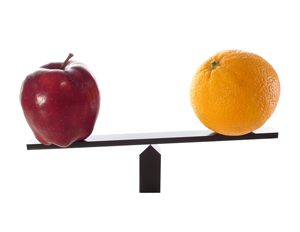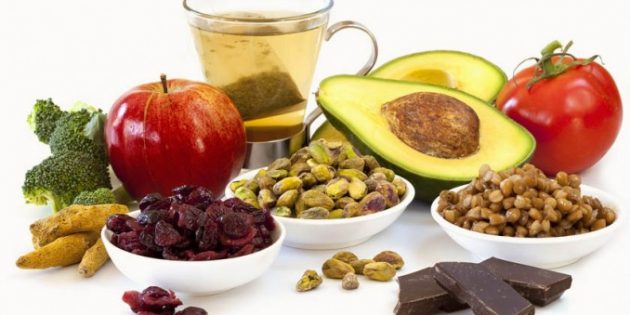The greatest way to fight free radicals (therefore slowing aging down) is to make sure you get plenty of antioxidants in your diet. Your first and most significant source will be from high quality, organic, and locally grown whole foods. Wisely chosen supplements have also been shown to be highly beneficial in addition to your food choices.
Thus the question arises: how do we get the best and most powerful antioxidants?
There is nothing to-date that states that one antioxidant is better than another. It can be evaluated by the strength of the antioxidant. But that doesn’t necessarily mean that only “strong” antioxidants will give you the best “effectiveness”.
Antioxidants should also be considered in terms of:
- what it can explicitly target (e.g. anti-inflammatory, anti-cancer, anti-aging, etc.),
- how it works
- how it works with other antioxidants
- how they work together, etc, etc
In the end, antioxidants function best as a group and different “groupings” are best for different situations. Some are also more effective with the support of non-antioxidant nutrients, such as selenium – see the Antioxidants’ Classification for what they do.
 The strength of antioxidants can be measured by the ORAC (Oxygen Radical Absorbance Capacity) score, the standardized test adopted by the U.S. Department of Agriculture (USDA) to measure the “total antioxidant potency” of foods and nutritional supplements. It offers a precise way (with certain key restrictions) of creating the free-radical-destroying power of a particular food or supplement. The higher a food’s ORAC score, the more potent it is in battling age-related degeneration and illness. The ORAC value, or “ORAC score” is a way of measuring the in vitro (outside of the human body) antioxidant capacity of various foods and supplements. More than two decades in the making, it was initially developed by scientists working at the USDA and National Institutes of Health (NIH).
The strength of antioxidants can be measured by the ORAC (Oxygen Radical Absorbance Capacity) score, the standardized test adopted by the U.S. Department of Agriculture (USDA) to measure the “total antioxidant potency” of foods and nutritional supplements. It offers a precise way (with certain key restrictions) of creating the free-radical-destroying power of a particular food or supplement. The higher a food’s ORAC score, the more potent it is in battling age-related degeneration and illness. The ORAC value, or “ORAC score” is a way of measuring the in vitro (outside of the human body) antioxidant capacity of various foods and supplements. More than two decades in the making, it was initially developed by scientists working at the USDA and National Institutes of Health (NIH).
Measuring in vivo (meaning inside the human body) is impossible and for that reason, the exact connection between the ORAC value of a food/supplement and any suspected health advantage it may have as a result is unverified. However, many scientists theorize that foods higher on the ORAC scale may be more effective at deactivating free radicals.
If you want to look up an ORAC score for the Top 100 check the
 ORAC Score for Top 100
ORAC Score for Top 100The ORAC values of the spices/herbs/foods in the list are rated very high (seemingly healthier) and are worth considering in your diet for your overall health and well-being.
Sounds simple: the higher the ORAC value, the better the antioxidant. Unfortunately, as always, the reality is more complex. And the huge knock on the ORAC score is that it’s done in a test tube, and sometimes what happens in a test tube has no correlation to what happens in your body. None.
K eep in mind, however, that although ORAC can be a beneficial tool, some manufacturers have found a way to misrepresent ORAC values with misleading practices which can lead you astray.
eep in mind, however, that although ORAC can be a beneficial tool, some manufacturers have found a way to misrepresent ORAC values with misleading practices which can lead you astray.
While United States Department of Agriculture (USDA) in 2012 has reserved this as a measure of the effectiveness of antioxidants from the intake of the foods, it is not totally dismissed as a measure. It can still be employed as a way to compare across the food types.
NOTE
- The ORAC values in this list are regulated to 100 grams of weight (about 3.5 ounces) because that is the way in which the original database of information was presented. The intent is to ‘normalize’ the numerous items to simply compare ‘raw value’, NOT ‘amount per serving’.
- The ORAC value of a given food will differ due to growing conditions, processing conditions, specific variety and others
- The free radicals used in an ORAC test don’t occur in the body
- There are about 1,234,845.6 different types of oxidizing reactions that can take place in your body, and an ORAC score measures exactly 1 of them
- ORAC scores can actually differ for the same food depending on the particular method used.
- ORAC scores can lower by as much as 90% when foods are cooked or processed
- Different antioxidant molecules behave very differently in an ORAC test
- The biological significance of the ORAC test has actually not been determined
- ORAC scores can be easily manipulated.
What would you do with $500? Sign up for one of LFBT & Healthline’s free e-News & Tips to enter! »
Alternative measures:
- Folin–Ciocalteu Reagent (FCR).
- Trolox Equivalent Antioxidant Capacity (TEAC). Similar to the ORAC measure, it measures antioxidant capacities.
What ORAC Numbers Don't Tell Us
Even if we speculate that the tested ORAC figures are accurate, it is imperative to understand that having a high ORAC value in and of itself does not advise any particular benefit. That's because not all antioxidants that are established as present in a test tube can be absorbed and utilized by the human body. It doesn't matter how high the value is in a test, if it doesn't function within the body, it has no value to you. Additionally, various antioxidants target various free radicals. Taking a supplement with an ORAC value of 17,000 that targets one group of free radicals still leaves you defenseless to the ones not targeted.
As well, be mindful of the fact that different antioxidants work in different areas of the body. The herb Ginkgo biloba, for instance, works in the brain and cardiovascular system, where curcumin is active in the colon and silymarin in the liver. As you can see, having 5,000 ORAC units working in the brain isn't much comfort if you have liver problems.
ORAC value communicates only a very minor part of the story. Saying that pycnogenol is twenty times more potent than vitamin C, for example, is worthless when it comes to scurvy. In that sense, vitamin C is markedly better than pycnogenol. Otherwise, to say that mangosteen is ten times stronger than noni is just as pointless. When it comes to raising nitric oxide levels, noni is infinitely tougher because mangosteen simply doesn't do that. On the other hand, mangosteen seems to have much stronger anti-pathogenic activity than noni. Thus, ORAC value by itself offers a very incomplete picture.
Lastly, there is a limit to how much you can benefit from an augmented intake of antioxidants. The maximum number of ORAC units the body can handle daily is about 3,000 to 5,000 units. This is because the antioxidant capacity of the blood is firmly controlled, so there is an upper limit to the value that can be wrought from antioxidants. Taking in 25,000 ORAC units at one time (as supposedly occurs with some mangosteen drinks, if you believe what you read on some websites) would be no more useful than taking in a fifth of that amount (at least in terms of its ORAC value). The surplus is simply excreted by the kidneys.
Let me rephrase this to make it even clearer: intaking more than 3,000--5,000 ORAC units a day of the same kind of antioxidant is akin to using a tank to go to the grocery store—it's overkill. And advocating those extremely high numbers in advertising is a bit like a car dealer trying to persuade you to buy that tank for your grocery shopping in the first place. It's less than honest.
Comparing Apples to Apples
 Now, let's go back to the problem I stated above--that ORAC values are ordinarily calculated on the basis of 100-gram portions. The reason is that ORAC was originally developed to provide information on whole foods, and a 100 grams works out to just under a 4-ounce portion. It is necessary, therefore, to make sure that the comparison cited for ORAC values is based on equivalent volumes (or servings). When sellers of mangosteen drinks claim ORAC standards far superior to other antioxidants, are they comparing serving to serving? Probably not. In most scenarios, they have stretched the numbers out to give the ORAC values in a liter/quart of mangosteen juice and then compared that to 1-ounce servings of other liquid antioxidant supplements.
Now, let's go back to the problem I stated above--that ORAC values are ordinarily calculated on the basis of 100-gram portions. The reason is that ORAC was originally developed to provide information on whole foods, and a 100 grams works out to just under a 4-ounce portion. It is necessary, therefore, to make sure that the comparison cited for ORAC values is based on equivalent volumes (or servings). When sellers of mangosteen drinks claim ORAC standards far superior to other antioxidants, are they comparing serving to serving? Probably not. In most scenarios, they have stretched the numbers out to give the ORAC values in a liter/quart of mangosteen juice and then compared that to 1-ounce servings of other liquid antioxidant supplements.
To get the true value per recommended 1-ounce serving, you would have to divide by 32, which takes you down to a more reasonable 500--600 ORAC units per serving. Don't get me wrong: I like mangosteen, but I don't think it's beneficial to overstate the numbers. And in addition, as I already mentioned, since antioxidant levels in the blood are strongly controlled by your body, there are probably no health benefits to numbers over 3,000--5,000 ORAC per day of a single antioxidant anyway.
And when it comes to capsules, most are 500 milligrams, which means it would take 56 capsules of a non-concentrated extract to equal an ounce of a food-based source of the antioxidants. In other words, it would take over 200 capsules to give you the same capacity as a 4-ounce serving of the same antioxidant-rich whole food. If you want the same antioxidant potency in a single capsule, then the ORAC value of the capsule needs to be 200 times more concentrated than the whole food in order to give you a comparable value. This can be done by eliminating the water and fiber which have no ORAC value. Grape skin extract, for example, has a much higher ORAC value than you'll find in whole grape skins, but this does not indicate that from a viewpoint of cost, dose, and/or serving that the extract is actually superior.
Be mindful, however, there is the convenience aspect. Isn't it worth paying a premium to easily supplement with a full-spectrum antioxidant that functions throughout the whole body and on all types of free radicals—an antioxidant that makes up for the fact that you aren't including all essential helpful foods in your daily diet? When you can make it work, absolutely.
Choosing Antioxidant Foods
When it comes to antioxidants, your first choice should be to include antioxidant rich foods in your diet. It promises that you're getting whole complexes and no synthetics. With that in mind, some foods are high in antioxidants and should be a consistent part of the diet. In fact, the U.S. Department of Agriculture recently assessed a large number of foods according to their ORAC values. Remember: the higher the number, the stronger the antioxidant effect. All ratings were based on 3.5 ounces of the tested food. As a reference, carrots (high in the carotenoids) had a 207 rating.
- Broccoli, 890
- Kale, 1,770
- Brussels sprouts, 980
- Blueberries, 2,400
- Spinach, 1,260
- Raisins, 2,830
- Strawberries, 1,540
- Prunes, 5,770
Don't forget that these foods are comprised of other phytonutrients that go well beyond their antioxidant value. Do not eat according to ORAC values alone. And do not make the mistake of thinking that you've covered your bases by concentrating on looking for the one food with the highest antioxidant value. Incidentally, freeze dried acai berry probably tops the list at 104,000, but that's not necessarily as good as it sounds because it's very low in anthocyanins and phenolics. Remember, each high-in-antioxidants food works in different parts of the body and on different free radicals. Eat as wide a range of antioxidant rich foods as you can, as frequently as you can.
The Ultimate Antioxidant
Unfortunately, trusting foods alone for your antioxidants—although it's exceptionally healthy—is probably not going to maximize the possible health advantages of antioxidants. As we have already discussed, it is practically impossible to gain all the antioxidants you need from diet alone—you would have to consume too much food to cover the full-spectrum of potential antioxidant benefits. And for reasons already mentioned, you certainly can't get there by eating a single high antioxidant food as suggested by many companies. Yes, the ORAC value can be high, but no single food covers the full range of your requirements. And that is the reason you want to consider intaking a full spectrum antioxidant supplement. That said, there is really no such thing as an "ultimate" antioxidant supplement, but there are some that come close.
You need to look for a formula that integrates something resembling the scope listed below and that approximates the levels of each ingredient as recorded. It may have more of any specific ingredient, but if it contains considerably less, it's simply there as label dressing (or "pixie dust" as we say in the trade). But again, when it comes to selecting ultimate antioxidants you can be guided by the list below:
- Get as wide a spectrum of antioxidants as possible so that they work in every area and every cell of your body.
- Use antioxidants that match each other rather than replicate each other
- Use full complexes where viable
- Pick natural over synthetic
- Evade all pixie dust ingredients. If an antioxidant can't fit in the formula because it requires too many milligrams, don't use it--don't put it in simply to look good on the label
 And when you are choosing the one that best for you, these are some of the factors to be considered:
And when you are choosing the one that best for you, these are some of the factors to be considered:
- Is it consumed for a specific purpose\need or, for general health?
- What does your body in need of most, at any point in time? That is to say, if you are given the best antioxidant but in fact, the body needs another type, then the best antioxidant may not be the best for you, at that point in time
- Antioxidants are a type of nutrients that works best as a group – hence, what then is the best combination for you?
As Dr. Passwater says it best, so I will conclude with a passage from his book, The Antioxidant Miracle:
"Combinations of antioxidants are like a balanced symphony working together. A symphony orchestra produces sounds so much more harmonious than merely having 20 drums playing. It is not the quantity, but the blend. The same is true with antioxidant nutrients: you get better results with moderate amounts of a full complement than you get with using very large amounts of just one nutrient...
For this reason, most of us in the field recommend that a person take a variety of antioxidants (a "cocktail"), not just a single substance.
The importance of synergism is that the antioxidant nutrients each contribute to the total protection. They work together in the antioxidant cycle and reach all body compartments--fat and water-based, blood and internal cell. They protect against all types of free radicals and reactive oxygen species. No one antioxidant can do all of this."
You may also like:
Free Radicals: Enemies Within. What Are They And How Are They Formed
Understanding Antioxidants. How Do They Work?
How Can We Recognize Antioxidant Rich Food?
The Most Common Sources Of Antioxidants
Classification Of The AntiOxidants
How Antioxidants Affect Our Health In General




